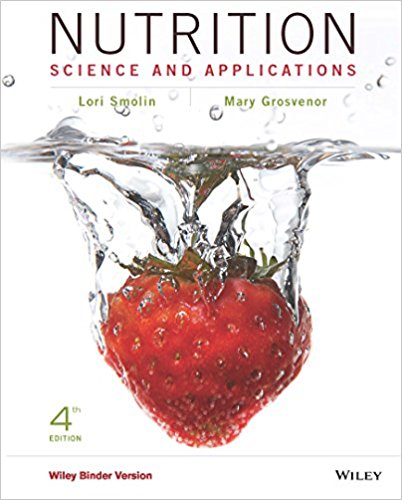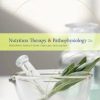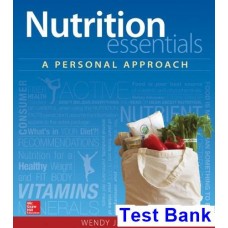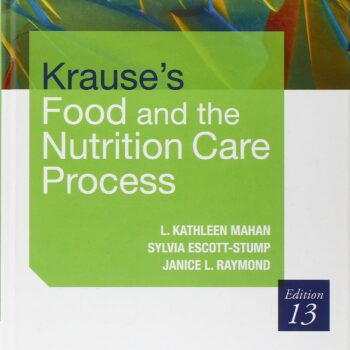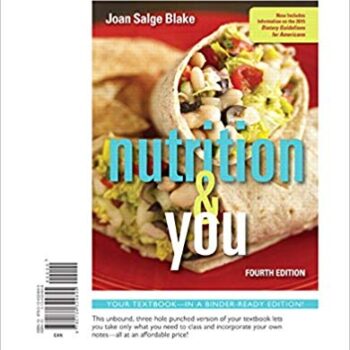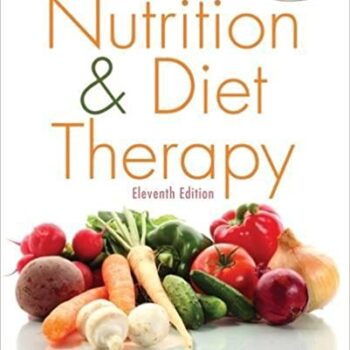In this time when everything is moving so fast, the right study tools are essential. Hence, we offer the Test Bank For Nutrition Science and Applications, Binder Ready Version, 4th Edition by Smolin and Grosvenor. Every student needs to excel in particular courses, and this often does not seem like an achievable target for most, as most fail to comprehend key topics. This test bank has been made especially for those who would like to expand their knowledge about nutrition and for those who would like to progress in their nutrition courses.
Why Choose Our Test Bank?
Our test bank is focused on the material contained in the book, meaning you will only encounter questions that are relevant to the syllabus at hand. These relationships ensure the enhancement of knowledge and make certain that every student is ready for any kind of test. Various types like MCQs and true false questions are included in the Test Bank For Nutrition Science and Applications making it appealing to different learners concerning the various question formats.
Key Topics Covered
- Introduction to Nutrition: Familiarize oneself with the basic concepts of nutrition and nutrition concepts so that they can be applied in real-life situations. Nutrition is the key to sustaining one’s health and so understanding some basic concepts will help individuals make more informed decisions when it comes to their diet.
- Macronutrients and Micronutrients: Be familiar with the structural details of carbohydrates, proteins, fat, vitamins, and minerals. Each of these nutrients is vital in the sustenance of health, growth, and energy provision.
- Digestion and Absorption: Know and appreciate how the body works in providing food and nutrients. This section describes the processes of food consumption, digestion, and absorption and explains the significance of all of these processes.
- Metabolism: Detail how food is transformed into energy in the body and how various nutrients participate in numerous metabolic pathways. It is essential to appreciate the concept of metabolism as this tells why and how our bodies use food for energy and other functions as well as what can alter this process.
- Nutrition and Health: The social dimension of this issue deals with the health effects of dietary influences with special emphasis on nutrition in chronic diseases. This subject deals with the ways through which diseases can be avoided by good nutrition and health.
- Dietary Guidelines and Planning: Gain preparing dietary patterns and understanding of the dietary approach and recommendations. Understand how to design meals that correspond to the needs of the body and those that favor healthy living.
Benefits of Using the Test Bank
There is much to gain from the utilization of our test bank. It systematically structures how you study and assess your understanding allowing for identification of knowledge gaps. Professionally constructed questions are sculpted to promote comprehension while fostering critical thought, both of which are necessary for the in-depth understanding of more difficult concepts in nutrition. Using the test bank regularly helps in better retention of information and also enhances one’s self-esteem in a particular subject.
How to Use the Test Bank Effectively
To maximize the benefits of the test bank, we suggest that the test bank should be incorporated into the student’s daily activities. First, go through the pertinent textbook sections, and thereafter, take the test bank questions set for you. This method of study will assist you in consolidating what you have covered and point out areas of concern that would require additional attention. Also, attempt to approximate actual exam settings when working on the test bank so that you get better prepared for real-life exams.
Summary
The Test Bank For Nutrition Science and Applications, Binder Ready Version, 4th Edition by Smolin and Grosvenor is an ideal option for students who wish to succeed in their nutrition studies. Since it contains rich content and is synced with your coursework, this test bank will simplify the learning process. Get the chance to develop and work towards achievable academic targets. However, with this test bank, you can confidently approach the subject of nutrition and ensure an equally good performance in your examination.
Test Bank For Nutrition Science and Applications, Binder Ready Version, 4th Edition Smolin, Grosvenor
Course Title: Smolin4e
Chapter Number: 3
Question Type: Multiple Choice
1) _________ are units of matter that cannot be further broken down by chemical means.
a) Organic compounds
b) Cells
c) Atoms
d) Solvents
Answer: c
Difficulty: Easy
Learning Objective: LO 3.1 Describe the organization of life and the organ systems that play a role in obtaining and using nutrients.
Section Reference: Section 3.1 Food Becomes Us
2) Nutrients classified as “organic molecules” have a molecular structure which contains the element:
a) carbon.
b) oxygen.
c) nitrogen.
d) sulfur.
Answer: a
Difficulty: Easy
Learning Objective: LO 3.1 Describe the organization of life and the organ systems that play a role in obtaining and using nutrients.
Section Reference: Section 3.1 Food Becomes Us
3) Which of the following sequences is organized from the simplest to the most complex arrangement?
a) atoms : molecules : tissues : organs
b) molecules : tissues : atoms : organs
c) tissues: atoms : molecules : organs
d) atoms : organs : tissues : molecules
Answer: a
Difficulty: Easy
Learning Objective: LO 3.1 Describe the organization of life and the organ systems that play a role in obtaining and using nutrients.
Section Reference: Section 3.1 Food Becomes Us
4) The movement of food through the digestive tract is regulated by:
a) the endocrine and nervous systems.
b) the lymphatic and muscular systems.
c) the respiratory and urinary systems.
d) the cardiovascular system.
Answer: a
Difficulty: Medium
Learning Objective: LO 3.1 Describe the organization of life and the organ systems that play a role in obtaining and using nutrients.
Section Reference: Section 3.1 Food Becomes Us
5) The most important roles of the digestive system include digestion and:
a) metabolism.
b) absorption.
c) circulation.
d) excretion.
Answer: b
Difficulty: Medium
Learning Objective: LO 3.2 Explain the gastrointestinal tract structure and the roles of mucus, enzymes, nerves, and hormones in the digestive tract.
Section Reference: Section 3.2 The Digestive System
6) The internal lining of the gastrointestinal tract is the:
a) submucosa.
b) serosa.
c) muscularis.
d) mucosa.
Answer: d
Difficulty: Easy
Learning Objective: LO 3.2 Explain the gastrointestinal tract structure and the roles of mucus, enzymes, nerves, and hormones in the digestive tract.
Section Reference: Section 3.2 The Digestive System
7) The digestive tract begins at the _________ and ends at the _________.
a) esophagus; small intestine
b) mouth; transverse colon
c) esophageal sphincter; pylorus
d) mouth; anus
Answer: d
Difficulty: Easy
Learning Objective: LO 3.2 Explain the gastrointestinal tract structure and the roles of mucus, enzymes, nerves, and hormones in the digestive tract.
Section Reference: Section 3.2 The Digestive System
8) Transit time is the rate at which food:
a) moves through the digestive tract.
b) is swallowed.
c) is absorbed into the blood.
d) is broken down into chyme.
Answer: a
Difficulty: Easy
Learning Objective: LO 3.2 Explain the gastrointestinal tract structure and the roles of mucus, enzymes, nerves, and hormones in the digestive tract.
Section Reference: Section 3.2 The Digestive System
9) Which of the following is NOT a product released by the GI tract?
a) Mucus
b) Enzymes
c) Chyme
d) Hormones
Answer: c
Difficulty: Easy
Learning Objective: LO 3.2 Explain the gastrointestinal tract structure and the roles of mucus, enzymes, nerves, and hormones in the digestive tract.
Section Reference: Section 3.2 The Digestive System
10) Which of the following is NOT an accessory organ of the digestive system?
a) Liver
b) Pancreas
c) Salivary glands
d) Kidney
Answer: d
Difficulty: Easy
Learning Objective: LO 3.2 Explain the gastrointestinal tract structure and the roles of mucus, enzymes, nerves, and hormones in the digestive tract.
Section Reference: Section 3.2 The Digestive System

